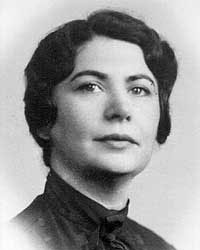Gertrude Blanch facts for kids
Gertrude Blanch (born February 2, 1897, in Kolno, now Poland – died January 1, 1996) was an American mathematician. She did important work in numerical analysis, which is about solving math problems using numbers and computers. She was a leader in the early days of computing.
Blanch led the Mathematical Tables Project in New York from its start. Later, she worked at UCLA in their computing division. She also led mathematical research for the Aerospace Research Laboratory at Wright-Patterson Air Force Base in Ohio.
Early Life and Education
Blanch was born on February 2, 1897, as Gittel Kaimowitz in Kolno, a town in what is now Poland. Her parents were Wolfe Kaimowitz and Dora Blanc. She was the youngest of seven children.
Her father moved to the United States. In 1907, when Blanch was ten, she, her mother, and one sister joined him in New York.
Blanch went to schools in Brooklyn, New York. She graduated from Eastern District High School in 1914. That same year, her father died. Blanch decided to get a job to help her family.
She worked in office jobs for 14 years, from 1914 to 1928. During this time, she saved money for school. She became an American citizen in 1921. After her mother died in 1927, Blanch started taking evening classes. She studied at Washington Square College, which is part of New York University.
In 1932, Blanch earned her Bachelor of Science degree in Mathematics from New York University. She also studied Physics. She graduated with top honors and was part of Phi Beta Kappa, a special academic group. That same year, she changed her name from Kaimowitz to Blanch. This was an Americanized version of her mother's name.
She then went to Cornell University. In 1935, she earned her Ph.D. in algebraic geometry. Her thesis was published in the American Journal of Mathematics in 1936.
Career in Computing
After getting her Ph.D., Blanch found it hard to find a job in math. This was because of the Great Depression, a time when many people were out of work. For one year, from 1935 to 1936, she taught at Hunter College. After that, she worked in an office job again.
Blanch took an evening class on relativity at Brooklyn College. The teacher, Arnold Lowan, learned about her math Ph.D. He invited her to join a special project.
In February 1938, she started working on the Mathematical Tables Project. This project was part of the WPA, a government program. Blanch became the mathematical director and led the Planning Committee.
As part of the Planning Committee, Blanch decided which math problems to solve. She also created the plans for how the calculations would be done. Other women, like Ida Rhodes and Irene Stegun, also worked on this committee. The committee managed 450 human computers. These were people who did math calculations by hand.
Blanch designed step-by-step instructions, called algorithms. Teams of human computers followed these instructions. Many of these computers did not have much math training. But Blanch's algorithms and error-checking methods were so good that their results were the best for decades. This project later became part of the National Institute of Standards and Technology.
During World War II, the Mathematical Tables Project became very important. It worked as a major computing office for the U.S. government. They did calculations for many war efforts. This included the Manhattan Project, which developed the atomic bomb. They also helped with Operation Overlord, the D-Day landings in Normandy. Blanch led the group throughout the war.
After the war, Blanch faced problems. The FBI thought she might be a communist. They looked into her life. For example, they noted she had never married or had children. They also noted her sister was linked to the Communist Party. In May 1952, a hearing cleared her name. She was then able to continue her important work.
After this, she worked at the Institute for Numerical Analysis at UCLA. When that closed in 1954, she worked for a company called Consolidated Engineering. Soon after, a friend from the Mathematical Tables Project, Knox Millsaps, hired her. She became a senior mathematician for the Aerospace Research Laboratory at Wright-Patterson Air Force Base in Ohio.
At the Air Force, she worked on math problems related to air flow and flight. In 1962, Blanch was promoted to a senior government scientist. She was also an early member of the ACM, a group for computing professionals.
Honors and Awards
Gertrude Blanch received many awards for her important work.
- Air Force Outstanding Performance Award (1958)
- Air Force Exceptional Service Award (1963)
- Fellow of the American Association for the Advancement of Science (1963)
- Federal Woman's Award (1964)
- Inducted into the Portrait Gallery at the National Institution of Standards and Technology (2017)
Later Years
Blanch retired in 1967 when she was 69 years old. But she kept working as a consultant for the Air Force through Ohio State University. She continued this until 1970.
After that, she moved to San Diego, California. There, she worked on a book about math problems until 1982, but it was never published. She also continued research on special math functions called Mathieu functions. She worked on finding ways to get very accurate results quickly. She continued this research until she passed away in January 1996.
Her papers, called the Gertrude Blanch Papers, 1932–1996, are kept at the Charles Babbage Institute at the University of Minnesota.
See also
 In Spanish: Gertrude Blanch para niños
In Spanish: Gertrude Blanch para niños


